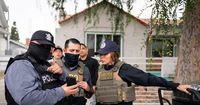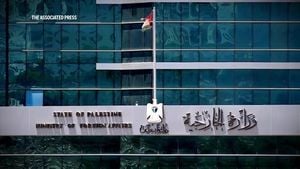On a humid August weekend in 2025, the streets of Washington, D.C. became the stage for a spectacle that few residents will soon forget. Federal agents, faces obscured and clad in tactical gear, swept through neighborhoods as part of President Donald Trump’s controversial federal takeover of the nation’s capital. The move, which has drawn sharp criticism from local leaders and national observers alike, has ignited a fierce debate over the balance of power, public safety, and the meaning of democracy in America’s seat of government.
The most jarring moment came on August 18, when unidentified agents were caught on camera violently tackling a food delivery driver in broad daylight. According to NBC News, the incident unfolded amid a heavy federal presence, with agents deployed throughout D.C. under the administration’s new emergency powers. The footage quickly went viral, sparking outrage and concern about the aggressive tactics being used by federal forces. Local leaders, including Baltimore Mayor Brandon Scott, did not mince words. He blasted the operation as a “dog and pony show,” calling Trump’s D.C. intervention a blatant “power grab.”
But the drama didn’t stop there. Just days earlier, in the city’s Mount Pleasant neighborhood—home to one of D.C.’s most vibrant Latino communities—an eight-person Immigration and Customs Enforcement (ICE) patrol tore down a large pro-immigration banner that read, “Chinga La Migra — Mount Pleasant Melts ICE.” As reported by The Daily Beast, the agents, whose faces were hidden behind masks, filmed themselves cutting down the sign. In a moment that seemed almost surreal, the removal of the banner revealed a sex toy perched behind it. The agents, apparently unfazed, left the dildo in plain view as they crumpled up the protest sign and tossed it in the trash.
The ICE video, which was later posted on social media, blurred out the object but captured the agents’ bravado. “We’re taking America back baby,” one agent declared to the camera. Switching to Spanish, he added, “This is for America. The United States is number one. We are turning things around again.” The agency’s official caption for the video was equally defiant: “ICE is dedicated to removing criminals from American cities, and D.C. is no exception. Make D.C. safe again!”
For many D.C. residents and local officials, these scenes were emblematic of a much broader struggle. President Trump has justified the federal intervention by repeatedly claiming that Washington, D.C. is “one of the most dangerous cities anywhere in the world.” Yet, as both The Daily Beast and Newsweek have pointed out, official crime data tells a very different story. In fact, D.C.’s violent crime rate is at its lowest point in 30 years, and the city doesn’t even crack the top 30 most dangerous U.S. cities with more than 100,000 residents. Axios has further reported that 13 of the 20 U.S. cities with the highest murder rates are actually in red states, raising questions about the true motives and effectiveness of the federal crackdown.
The Trump administration’s actions in D.C. have gone far beyond policing. According to The Daily Beast, the White House has made moves to seize control of the city’s police department, seeking to install its own “emergency” police chief. This effort has not gone unchallenged. Last week, the District of Columbia’s top prosecutor filed a lawsuit against the White House, describing the maneuver as a “hostile” takeover of the city’s government. The legal battle has heightened tensions between local and federal authorities, with D.C. leaders arguing that the administration’s actions threaten the city’s autonomy and the very principles of home rule.
Meanwhile, the federal presence has brought a wave of high-profile—and sometimes bizarre—incidents. In addition to the food delivery driver’s violent arrest and the Mount Pleasant banner episode, there have been reports of SWAT teams sent to apprehend protesters for minor offenses, such as throwing a sandwich at ICE agents. As The Daily Beast reported, one such protester was targeted by a full SWAT team even after his lawyer said he was trying to turn himself in. These heavy-handed tactics have drawn comparisons to other controversial crackdowns on dissent, with critics warning that the normalization of such force could have lasting consequences for civil liberties.
Political leaders across the spectrum have weighed in, often with sharply divided views. Baltimore Mayor Scott’s condemnation of the operation as a “power grab” was echoed by other Democratic officials, who have accused the Trump administration of using law enforcement as a political weapon. California Governor Gavin Newsom, for instance, publicly urged Democrats to “fight fire with fire,” according to NBC News, while characterizing Trump’s actions as provocative and dangerous. On the other side, Trump and his supporters have defended the intervention as necessary to restore order and protect American citizens. “ICE is dedicated to removing criminals from American cities, and D.C. is no exception,” the agency insisted in its statement.
Adding fuel to the fire, President Trump has threatened to extend similar federal takeovers to other cities with Democratic leadership, though legal experts note that unlike Washington, D.C., most American cities are not under direct federal control. The president’s rhetoric has left many wondering how far the administration might go in its quest to “make America safe again,” and whether these moves signal a new era of federal intervention in local affairs.
The mounting controversy has also exposed deep divisions over the role of protest, immigration, and public safety in American life. “Chinga La Migra”—the phrase emblazoned on the Mount Pleasant banner—has become a rallying cry for pro-immigrant activists, especially as the Trump administration ramps up its mass deportation efforts. The phrase, which roughly translates to an expletive-laden rejection of ICE, reflects the anger and frustration felt by many in immigrant communities who see themselves as targets of government overreach.
As the legal and political battles play out, everyday residents of Washington, D.C. are left to navigate a city transformed by federal presence—where masked agents patrol the streets, protests are met with overwhelming force, and the boundaries between local and national power are being tested like never before. For some, these events are a sobering reminder of the fragility of democratic norms. For others, they represent a necessary response to perceived lawlessness and disorder.
Whatever one’s perspective, the events of August 2025 in Washington, D.C. have laid bare the tensions at the heart of American democracy—between security and liberty, federal authority and local control, protest and policing. As the city’s residents look to the future, the outcome of this standoff may well shape the nation’s understanding of who holds power in the capital, and at what cost.




